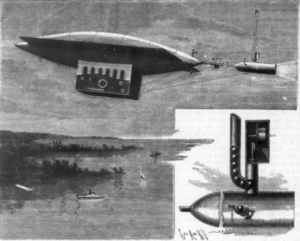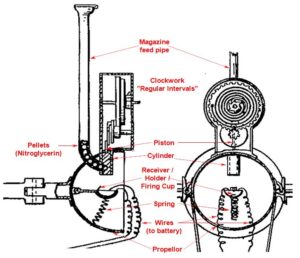I’ve previously included a link to Dr Battey’s (1893) “Aerial Machine” patent on Google Patents (it was even cited in a 2018 patent!), because it seems to me to share many features with the mysterious airship in the 1896 & 1897 Airship Flaps. I thought it would be useful to post a description of Battey’s patent, particularly its novel propulsion back-end. So… here we go, then.
Battey’s Aerial Machine
Here’s the artist’s impression of Battey’s airship published in Scientific American. The main sections are the streamlined balloon envelope, the wings on the side (for ascending and descending), the gondola below, and the curious-looking propulsion device on the back, all connected via standard Heath Robinson ropes / pulleys / sprockets straight out of every Victorian schoolboy’s My First Engineering Kit.
Battey doesn’t claim anything inventive about the aerodynamic balloon envelope. He describes this as having “the shape of a double cone with the bases united […] preferably made of light sheet metal, such as aluminum”. Internally, the envelope is “strengthened […] by a suitable framework […], preferably composed of vertical and transversely disposed braces”. His innovation is all in his “propellor”…
Battey’s Propellor
What Battey actually “claim[ed] as new and desire[d] to secure by Letters Patent” is his “propellor”, by which he means the mechanism to propel an airship forward. To illustrate this, I’ve grabbed the two relevant figures from his granted patent, cleaned them up (by removing all the arrows and letters), and then annotated the various parts in red using the terms used in the text.
As embodied here, the entire “propellor” mechanism is driven by the ticking of a clockwork mechanism (driven by a clock mainspring), which at regular intervals pushes a piston downwards along a short vertical cylinder. This piston (somehow) drags a nitroglycerin pellet out from the end of a J-shaped magazine feed pipe, and then pushes that pellet downwards towards a firing cup. When the pellet lands in the firing cup, the pellet itself completes a circuit between two wires connected to a battery (not shown), causing the pellet to explode. The shock from the detonation hits the dish-shaped propellor, and so propels the aerial machine forward: the spring beneath the firing cup yields, and so the firing cup is not damaged by the explosion.
Your thoughts, Nick?
Many people’s immediate reaction to this design would be that anyone who would combine a huge airship envelope full of hydrogen with external explosions every few seconds was a suicidal maniac. But knowing a little more about balloon history, I’m not sure that’s entirely fair.
In the 1930s, one of Jean Piccard’s innovations with his Pleiades multi-balloon setup was to attach explosive charges to ropes to release groups of balloons: before that, balloonists had used knives or even pistols to do the same thing, but these were often highly unsatisfactory. At the time, everyone thought Piccard was insane, but it wasn’t many years before just about everyone started copying him. So maybe Dr Battey’s design wasn’t quite so, ummm, batty after all.
The key limitation on the range of Battey’s airship would seem to be how many explosive pellets would fit in the magazine feeder pipe. If a pellet exploded every, say, six seconds, then you’d need ten pellets per minute. Annoyingly, the design doesn’t seem to have any means of stopping the clockwork piston (the only control over the mechanism seems to be to disconnect the battery), so it seems that once started the piston would keep pushing pellets down the cylinder until the magazine was empty.
So… the maximum length of a single flight would be determined by the number of pellets in the magazine. Even taking the dimensions of the magazine broadly as drawn (say, 5cm diameter x 2m tall), its capacity would be about 4,000 cm³ (and unless anyone knows better, I’d guess each explosive pellet would be about 1 cm³ in volume), so around 3500 or so pellets. This would give roughly 350 minutes of flight on a single magazine load, which would seem to be plenty for reasonable length night flights.
But would these nitroglycerin pellets have been powerful enough to propel Battey’s aerial machine at all? The figures given by Wikipedia are 1.6 g/cm³ for density, and 1.488 kilocalories per gram, so a 1 cm³ pellet would contain 2.38 kilocalories of energy. I believe that this is about half the energy density of gasoline, but I would be happy to be corrected.
I suspect the easiest way by far to determine how much power this would produce in practice (without all the losses to heat, light and sound etc) would be to build a test rig, but given that I have precisely zero desire to have the anti-terrorist squad kicking my door down, I’m not going to be doing this. Sorry for not going 100% gonzo on this etc etc.


Nick – you could go just a little bit gonzo? I think the Birdman Rally is beckoning !
https://www.onlymelbourne.com.au/moomba-birdman-rally
Jo: the Birdman Rally sounds like a lot of fun, if mainly for the drinks afterwards. 😁
Using explosive charges to sever a rope and using them to power an airship are very different things.
An engineer could calculate whether Battey’s engine could hit a ‘sweet spot’– producing explosions large enough to propel an airship but small enough to avoid igniting the hydrogen. Fully 19 years after the mystery airship sightings Robert Goddard discovered that his powder rockets were converting only about two percent of the thermal energy in their fuel into thrust and kinetic energy; and the heat liberated during nitroglycerine detonation raises the temperature of the gaseous byproducts to about 5,000 °C (9,000 °F). These facts raise some questions.
The Sacramento mystery airship reports in the newspapers also imply that any explosions would need to produce a continuous light and be practically silent.
Nitroglycerine is also unstable. (Back in our safecracking days, we always handled the stuff very carefully.) This raises an additional issue: what effect might an explosion in the firing cup have on the charges in the magazine?
This design looks quite impractical and very dangerous. Besides the fact that all the propellor should be very heavy, probably too heavy for a flying machine, the feeding mechanism is extremely dangerous.
Basically, it should work a bit like Diesel engines, but with nitroglycerin pellets instead of gasoline. So, the cylinder has a slot, a small chamber, to accomodate just one nitroglycerin pellet: when the cylinder is up, the chamber is at the same height of the end of the feed pipe, so a nitroglycerin pellet slips into the chamber by gravity. When the cylinder goes down, the surface of the cylinder occludes, and hopefully shields, the feed pipe. The problem here is what happens if the nitroglycerin pellet does not slip smoothly into the cylinder: if the pellet gets stuck and the cylinder goes down, there is a high risk of explosion right at the mouth of the feed pipe. That is firing on all cylinders, the wrong way.